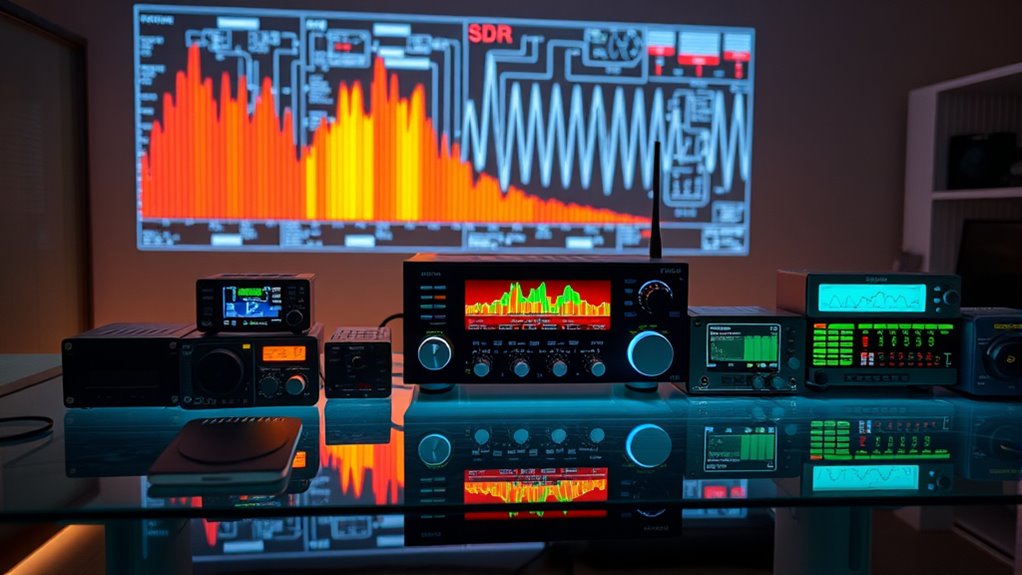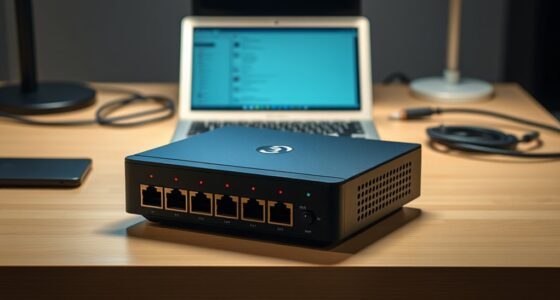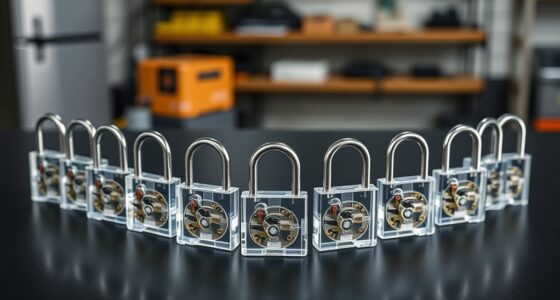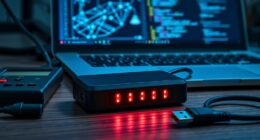If you’re searching for the 14 best SDRs for 2025, you’ll find options that suit beginners, hobbyists, and professionals alike. From affordable RTL-SDR dongles with dipole kits to high-stability models with built-in upconverters and antennas, there’s a device for every budget and need. These SDRs offer broad frequency coverage, enhanced stability, and compatibility with various software tools. Keep exploring, and you’ll discover more about each device’s features to find the perfect match.
Key Takeaways
- The list includes a range of SDRs from entry-level models to professional-grade devices for diverse user needs.
- Key features such as broad frequency coverage, high stability, and improved filtering enhance performance.
- Compatibility with multiple operating systems and software like GNU Radio and SDR# ensures versatility.
- Specialized options like high-precision TCXOs and upconverters cater to advanced spectrum analysis.
- Considerations such as ease of setup, durability, and reception limitations are addressed for different skill levels.
V4 R828D RTL2832U SDR with Dipole Antenna Kit
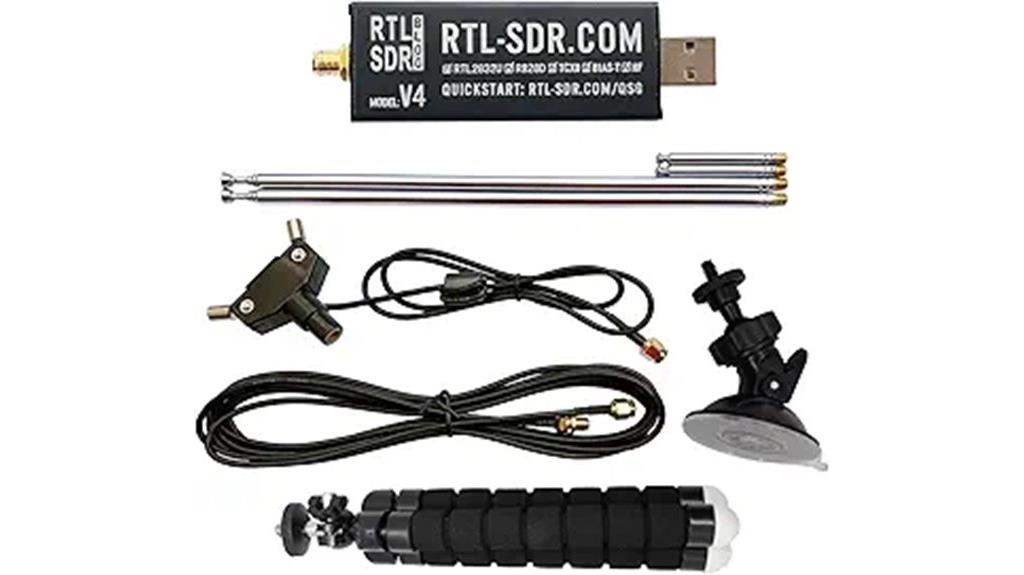
The V4 R828D RTL2832U SDR with Dipole Antenna Kit is an excellent choice for beginners and hobbyists looking for a versatile, budget-friendly SDR that delivers reliable performance across a wide frequency range. It features a high-quality RTL2832U ADC chip, an R828D tuner, and a built-in HF upconverter, making it suitable for receiving signals from 500 kHz to 1.766 GHz. The device’s aluminum case provides passive cooling, while upgrades like improved filtering and ESD protection enhance stability. The included dipole antenna kit is portable and easy to adjust, perfect for indoor or outdoor use. Overall, this SDR offers great value for those starting their radio journey.
Best For: beginners and hobbyists seeking a versatile, budget-friendly SDR capable of reliable wide-frequency reception for terrestrial, satellite, and radio signals.
Pros:
- Wide frequency coverage from 500 kHz to 1.766 GHz with stable performance
- Comes with a portable, adjustable dipole antenna kit suitable for indoor and outdoor use
- Built-in HF upconverter and improved filtering enhance signal clarity and stability
Cons:
- Setup and software configuration can be complex for beginners
- Driver updates and Windows updates may disrupt operation, requiring reinstallation
- The USB connector is fragile, necessitating careful handling or use of a hub for stability
V4 R828D RTL2832U 1PPM TCXO SMA Software Defined Radio (Dongle Only)
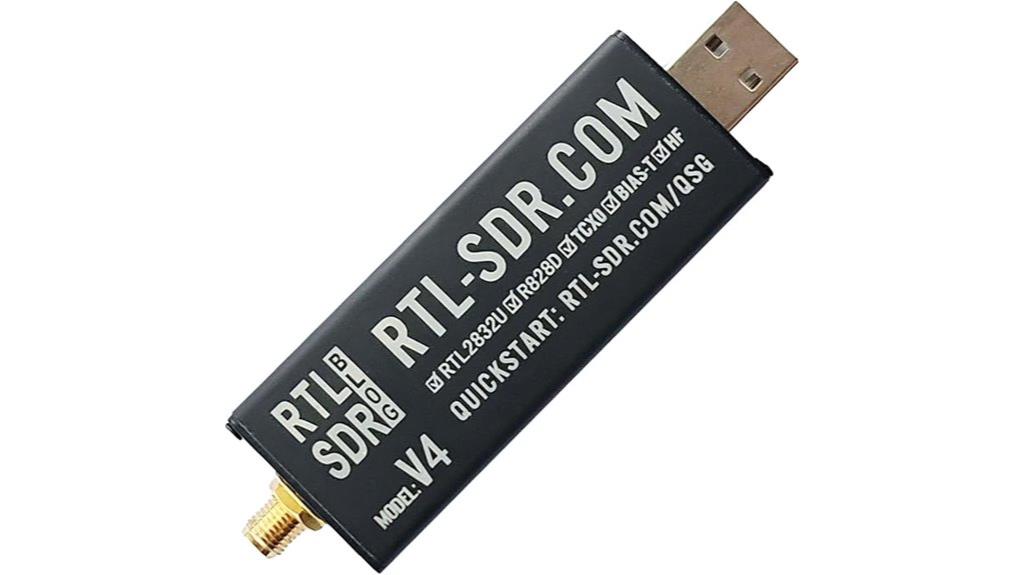
If you’re serious about HF listening or spectrum monitoring, the V4 R828D RTL2832U with 1PPM TCXO stands out as an excellent choice for both enthusiasts and professionals. This SDR covers 500 kHz to 1.766 GHz with up to 3.2 MHz bandwidth, enhanced filtering, and a built-in HF upconverter. Its 1PPM TCXO guarantees stability, while passive cooling and improved components boost sensitivity and reliability. Compatible with multiple operating systems and popular software, it’s a versatile tool for wideband RF analysis. Though setup requires careful driver updates, users praise its performance, especially on HF and VHF bands, offering great value for serious radio hobbyists.
Best For: serious HF listeners, spectrum monitors, and radio enthusiasts who require wide frequency coverage, enhanced stability, and reliable performance for wideband RF analysis.
Pros:
- Wide frequency coverage from 500 kHz to 1.766 GHz with up to 3.2 MHz bandwidth
- Built-in HF upconverter and 1PPM TCXO ensure stable, high-quality signals
- Compatible with multiple operating systems and popular SDR software for versatile use
Cons:
- Setup requires careful driver updates and configuration, which may be challenging for some users
- Limited performance at certain frequencies like 868 MHz according to some user feedback
- Passive cooling, while effective, may not be sufficient for prolonged high-power use without additional cooling measures
V3 R860 RTL2832U Software Defined Radio with Dipole Antenna Kit
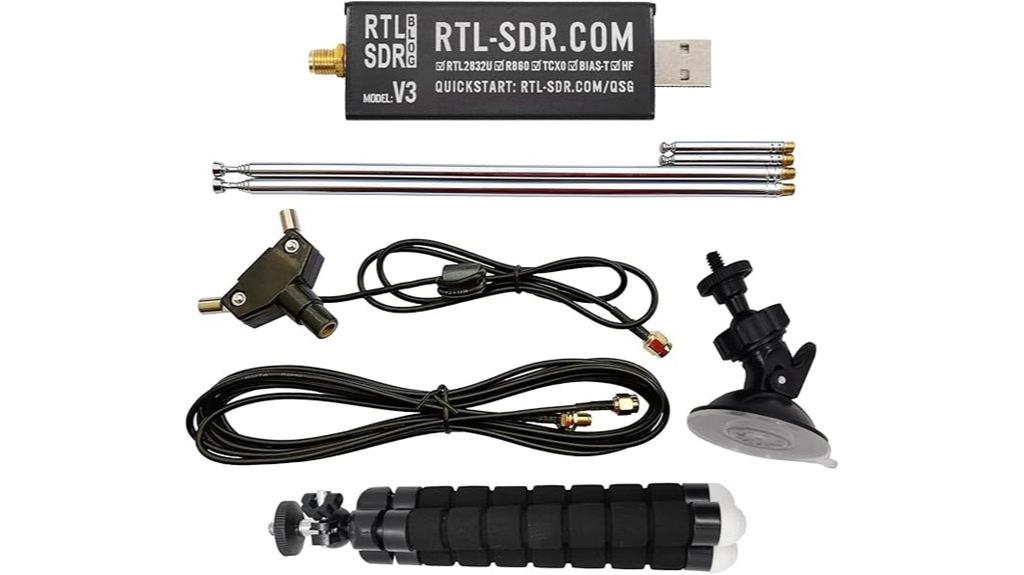
For beginners and outdoor enthusiasts seeking a portable, easy-to-use SDR, the V3 R860 RTL2832U with Dipole Antenna Kit stands out. It includes the RTL-SDR Blog V3 R860 dongle with a 1PPM TCXO for improved stability, a thermal shield for passive cooling, and an activatable bias tee. Its frequency range spans from 500 kHz to 1.7 GHz, supporting terrestrial and satellite reception. The kit’s multipurpose dipole antenna is designed for outdoor setups, making it ideal for temporary or portable use. While limited to RX only, this rig offers enhanced tuning, stability, and a user-friendly experience for beginners exploring radio signals.
Best For: beginners and outdoor enthusiasts seeking a portable, easy-to-use SDR for terrestrial and satellite radio reception.
Pros:
- Includes a high-stability 1PPM TCXO for improved frequency accuracy
- Designed for outdoor portability with a durable aluminum shielded case and thermal pad
- Supports a wide frequency range from 500 kHz to 1.7 GHz with stable bandwidth
Cons:
- Limited to receive-only functionality (RX only)
- Less effective for HF reception below 24 MHz in certain modes
- Not suitable for use during poor weather conditions or for long-term stationary setups
Nooelec RTL-SDR v5 Bundle Software Defined Radio
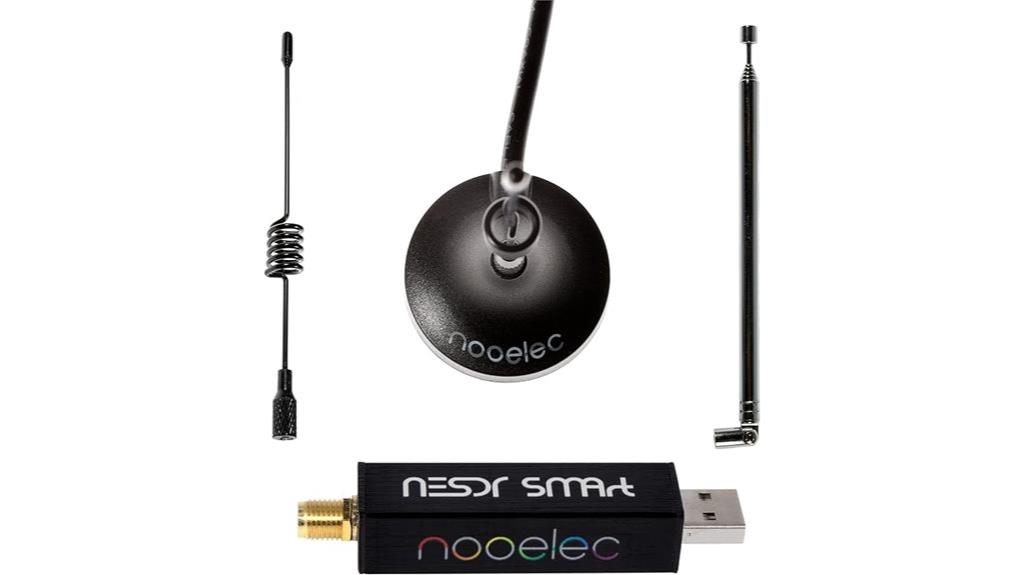
The Nooelec RTL-SDR v5 Bundle stands out as an excellent choice for both enthusiasts and professionals seeking versatile and high-performance radio reception. It covers a frequency range from 100kHz to 1.75GHz, supporting a wide variety of signals like weather satellites, aviation, and satellite communications. With up to 15dB improved HF SNR and four times greater tuning accuracy than previous models, it delivers sharp, reliable reception. The bundle includes antennas, a magnetic base, and cables, making setup straightforward. Compatible with Windows, Mac, Linux, and Android, it transforms your device into a powerful RF scanner or ham radio receiver, perfect for many applications.
Best For: hobbyists, amateur radio operators, and professionals seeking a versatile and high-performance SDR for wideband RF reception across multiple platforms.
Pros:
- Supports a broad frequency range from 100kHz to 1.75GHz for diverse applications
- Up to 15dB HF SNR improvement and fourfold increase in tuning accuracy over previous models
- Compatible with Windows, Mac, Linux, and Android, offering flexible device integration
Cons:
- Requires suitable antennas, especially for optimal HF reception, which may involve additional purchases
- Direct sampling HF operation below 25MHz needs specific antennas like long wires or dipoles with a Balun One Nine (sold separately)
- Slightly higher cost compared to entry-level SDRs, reflecting its advanced features and performance
The Hobbyists Guide to the RTL-SDR: Really Cheap Software Defined Radio
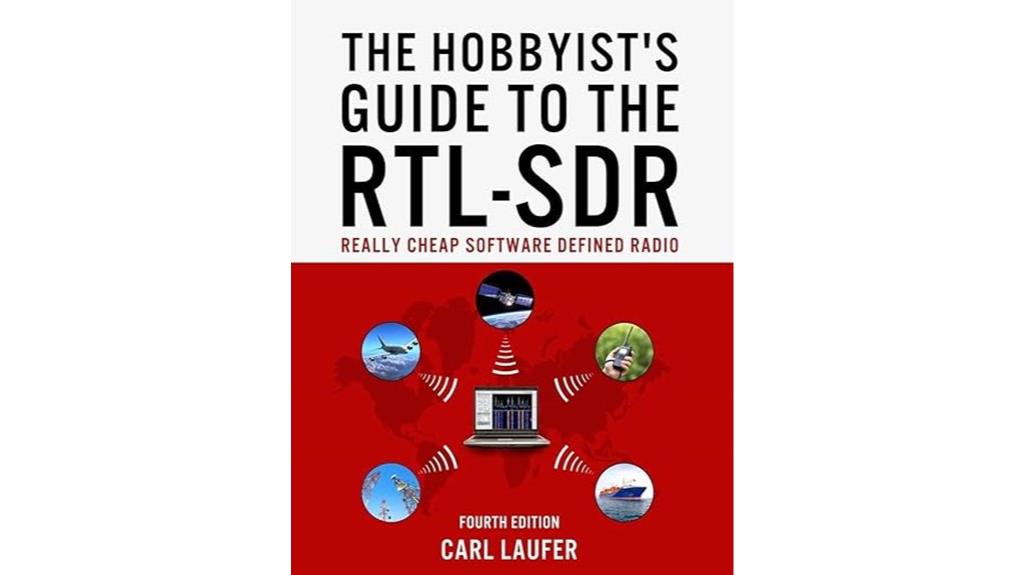
As a beginner or hobbyist exploring the world of Software Defined Radio, I find the RTL-SDR dongle to be an incredibly affordable and versatile starting point. This guide, “The Hobbyists Guide to the RTL-SDR,” offers straightforward instructions for setup, troubleshooting, and understanding key concepts. It covers applications from shortwave listening to satellite reception, making it a valuable resource. While some content is a bit outdated and print quality isn’t perfect, the book’s practical tips and tutorials are ideal for newcomers. Overall, it’s a fantastic introduction that encourages experimentation, especially when combined with online resources for the latest developments.
Best For: beginners and hobbyists seeking an affordable, practical introduction to Software Defined Radio and its basic applications.
Pros:
- Clear, accessible instructions suitable for newcomers
- Wide coverage of applications including shortwave, satellite, and weather reception
- Practical tips and tutorials that encourage experimentation and learning
Cons:
- Some content is outdated due to the rapid evolution of SDR technology
- Print quality issues, such as small and light font, may affect readability
- Limited coverage of advanced topics, which may require supplementary online resources
Nooelec RTL-SDR v5 Software Defined Radio

If you’re looking for a versatile and high-performance SDR suitable for both hobbyist experimentation and professional applications, the Nooelec RTL-SDR v5 stands out. It covers 100kHz to 1.75GHz, supporting everything from broadcast radio to satellite tracking. Compatible with Windows, Mac, Linux, and Android, it’s easy to integrate into various setups, including Raspberry Pi. With improved HF SNR, tuning accuracy, and a stable TCXO, it offers excellent reception. Its compact size and broad frequency range make it ideal for visualizing signals, decoding data, and exploring radio communications, whether you’re a hobbyist or a professional.
Best For: hobbyists, ham radio operators, and professionals seeking a versatile, high-performance SDR for a wide range of radio applications.
Pros:
- Wide frequency coverage from 100kHz to 1.75GHz with high stability and improved SNR
- Compatible with multiple operating systems including Windows, Mac, Linux, and Android
- Compact, durable design suitable for portable use and integration with embedded devices like Raspberry Pi
Cons:
- Requires external antennas and possibly an upconverter for optimal HF reception
- Power considerations when used with phones or tablets may necessitate powered USB cables
- Slightly more complex setup for beginners unfamiliar with SDR software and antenna configurations
Nooelec HackRF One SDR Bundle with ANT500 & SMA Adapters
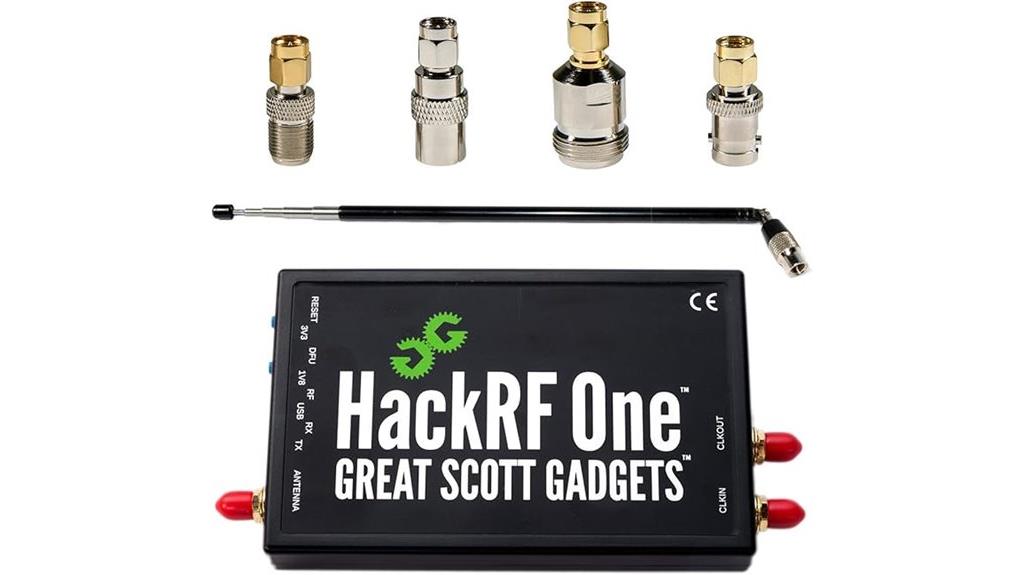
For enthusiasts and professionals seeking a versatile, high-performance SDR, the Nooelec HackRF One Bundle stands out as an excellent choice. It covers 1MHz to 6GHz with a 20MHz bandwidth, supporting both reception and transmission. The bundle includes the HackRF One device, an ANT500 telescopic antenna, SMA adapters, and a micro USB cable, making setup straightforward. Its open-source design works with GNU Radio, SDR#, and other software, ideal for RF testing, development, and experimentation. The adjustable ANT500 antenna offers broad coverage from 75MHz to 1GHz. While powerful and flexible, it has a learning curve but is highly valued for its expandability and community support.
Best For: hobbyists, cybersecurity professionals, and HAM radio enthusiasts seeking a versatile SDR for RF testing, development, and experimentation across a wide frequency range.
Pros:
- Wide frequency range of 1MHz to 6GHz with 20MHz bandwidth for diverse applications
- Open-source compatibility with popular software like GNU Radio and SDR# for customization and advanced use
- Includes a comprehensive bundle with antenna, SMA adapters, and USB cable for easy setup
Cons:
- Steep learning curve for beginners unfamiliar with SDR technology and configuration
- Relatively expensive compared to entry-level SDR options like RTL-SDR dongles
- Limited bandwidth for certain applications such as Wi-Fi analysis and high-speed data transfer
Nooelec NESDR Smart HF Bundle Set
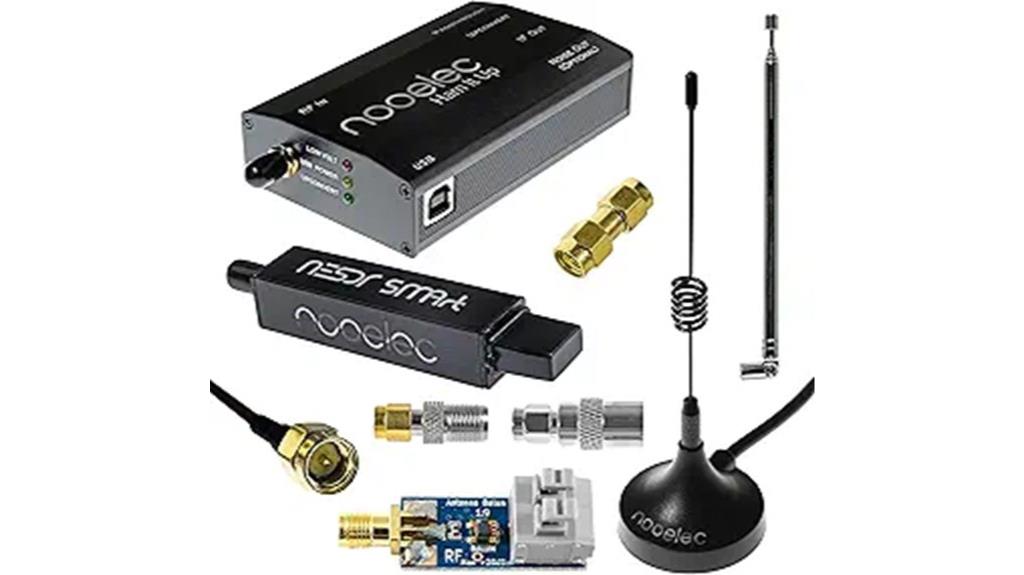
The Nooelec NESDR Smart HF Bundle Set stands out as an excellent choice for hobbyists and beginners enthusiastic to explore HF, UHF, and VHF radio bands without the need for complicated setups. It offers a wide frequency range (100 kHz-1.7 GHz) with an included Ham It Up v1.3 upconverter for HF reception. The bundle features a durable RTL-SDR receiver, three antennas, and essential adapters, all manufactured in North America. Its portability and versatility make it ideal for traveling and various projects. While setup can be tricky for newcomers, the comprehensive accessories and support help ease the process. Overall, it’s a solid, value-packed SDR for those eager to immerse themselves in radio exploration.
Best For: hobbyists and beginners eager to explore HF, VHF, and UHF radio bands with a portable, versatile SDR setup that offers extensive coverage and expandability.
Pros:
- Wide frequency range (100 kHz-1.7 GHz) with included upconverter for HF signals
- Durable build quality with North American manufacturing and comprehensive accessories
- Portable and easy to transport, suitable for traveling and various projects
Cons:
- Setup can be complex for newcomers, especially driver installation and software configuration
- The SDR runs hot; requires good airflow or cooling solutions during extended use
- Software setup and tuning may require technical knowledge and troubleshooting for optimal performance
Nooelec NESDR Mini USB RTL-SDR & ADS-B Receiver Set
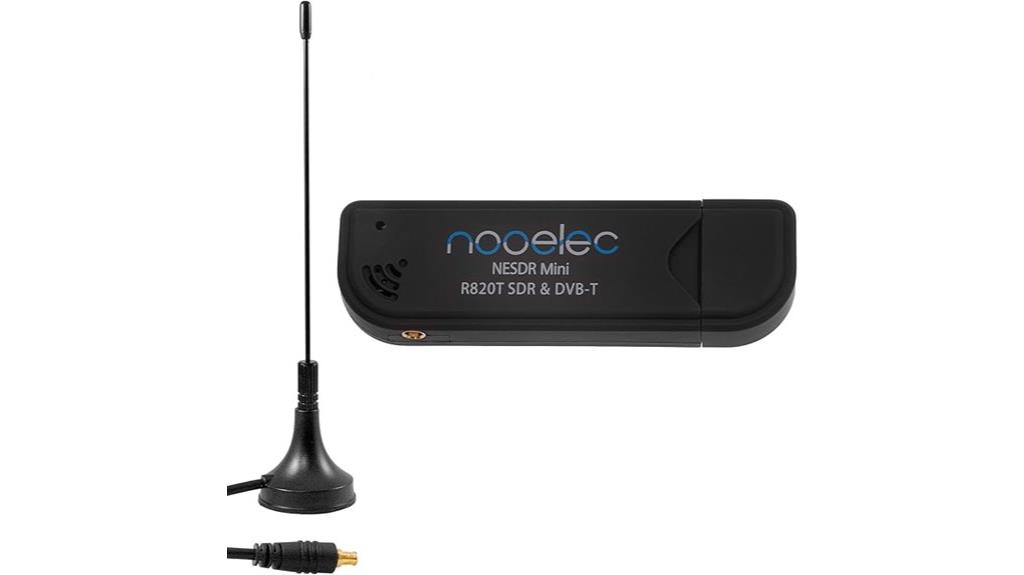
Among the top choices for hobbyists and professionals alike, the Nooelec NESDR Mini USB RTL-SDR & ADS-B Receiver Set stands out with its high sensitivity and reliable reception. It features an RTL2832U interface IC and R820T tuner IC, offering enhanced sensitivity and selectivity. The compact USB dongle includes an MCX antenna input, ensuring stable signal connection. Compatible with various SDR software, it’s perfect for ADS-B tracking and general SDR experiments. Plus, it comes with a 1-year warranty and support, making it a dependable, affordable option for anyone seeking a versatile SDR solution. Its custom tuning surpasses generic alternatives, providing excellent performance across applications.
Best For: hobbyists and professionals seeking an affordable, high-performance SDR receiver for applications like ADS-B tracking and general radio experimentation.
Pros:
- High sensitivity and reliable signal reception with R820T tuner IC
- Compatible with various SDR software platforms for versatile use
- Includes a durable antenna input with ESD protection and a 1-year warranty
Cons:
- May require some technical knowledge to set up and optimize
- Limited to USB connectivity, which might restrict mobility in certain scenarios
- Slightly larger footprint compared to ultra-compact SDR devices
V3 R860 RTL2832U 1PPM TCXO SMA Software Defined Radio (Dongle Only) (Black)
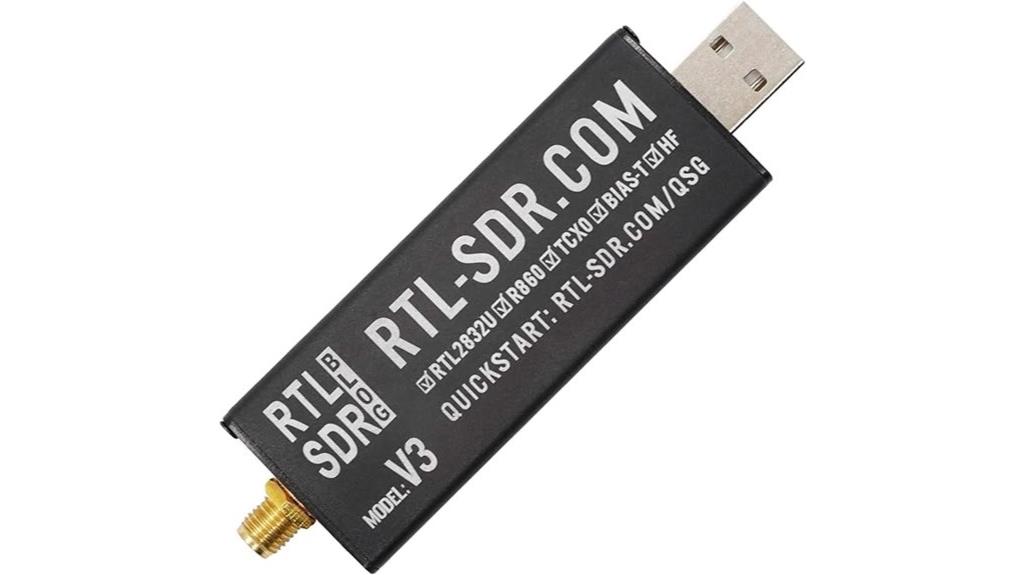
If you’re seeking a reliable SDR that combines high-precision tuning with passive cooling, the V3 R860 RTL2832U dongle is an excellent choice. It features the advanced R860 tuner, offering improved component tolerances for better stability. The 1 PPM TCXO guarantees precise frequency accuracy, ideal for demanding applications. Its aluminum shielded case with a thermal pad provides passive cooling, reducing heat-related issues. The SMA connector allows versatile antenna connections, and the optional bias tee supports active antennas. Supporting tuning from 500 kHz to 1.7 GHz with up to 3.2 MHz bandwidth, this dongle delivers solid performance for hobbyists and professionals alike.
Best For: hobbyists and professionals seeking a high-precision, passively cooled SDR with versatile antenna options and stable frequency performance.
Pros:
- Features the advanced R860 tuner with improved component tolerances for enhanced stability
- Equipped with a 1 PPM TCXO for precise frequency accuracy
- Includes an aluminum shielded case with thermal pad for passive cooling and heat dissipation
Cons:
- Supports only receive (RX) functionality, not transmit
- Tuning range limited to 500 kHz to 1.7 GHz, which may not cover all desired frequencies
- Requires driver installation and software setup, which could be complex for beginners
V4 R828D RTL2832U Software Defined Radio (Dongle Only)
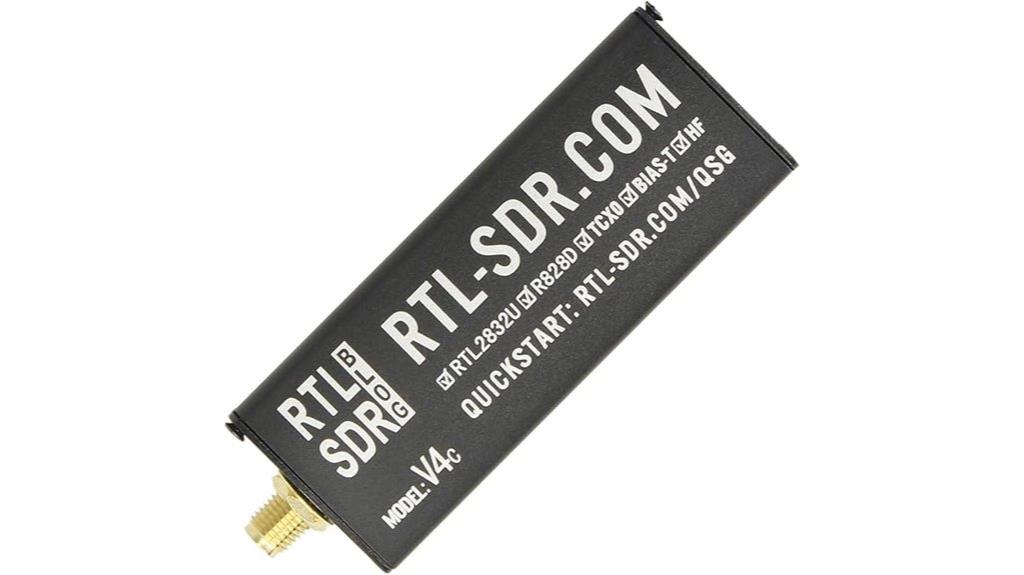
Designed for enthusiasts and professionals alike, the V4 R828D RTL2832U SDR dongle offers exceptional wide-range reception from 500 kHz to 1.766 GHz, making it ideal for versatile radio monitoring. It features an RTL2832U ADC, R828D tuner, 1PPM TCXO, and built-in HF upconverter, with improved filtering and passive cooling in an aluminum case. Supporting up to 3.2 MHz bandwidth (2.4 MHz stable), it’s compatible with popular software like SDR#, GQRX, and SDR Touch across Windows, Linux, OSX, Android, and Raspberry Pi. Its low noise, stable performance, and external antenna support make it a reliable choice for hobbyists and professionals.
Best For: amateur radio enthusiasts, spectrum analyzers, and professionals seeking a versatile, wide-range SDR receiver with stable performance and compatibility across multiple platforms.
Pros:
- Wide frequency coverage from 500 kHz to 1.766 GHz with a stable 2.4 MHz bandwidth
- Built-in HF upconverter, improved filtering, and passive cooling for enhanced signal quality
- Supports multiple operating systems including Windows, Linux, OSX, Android, and Raspberry Pi with popular SDR software
Cons:
- Requires driver updates and proper cable selection for optimal operation, which can be challenging for some users
- Limited to RX-only reception, not suitable for transmission purposes
- Customer reviews indicate occasional setup difficulties and variability in cable compatibility
Nooelec GOES Weather Satellite RTL-SDR Bundle
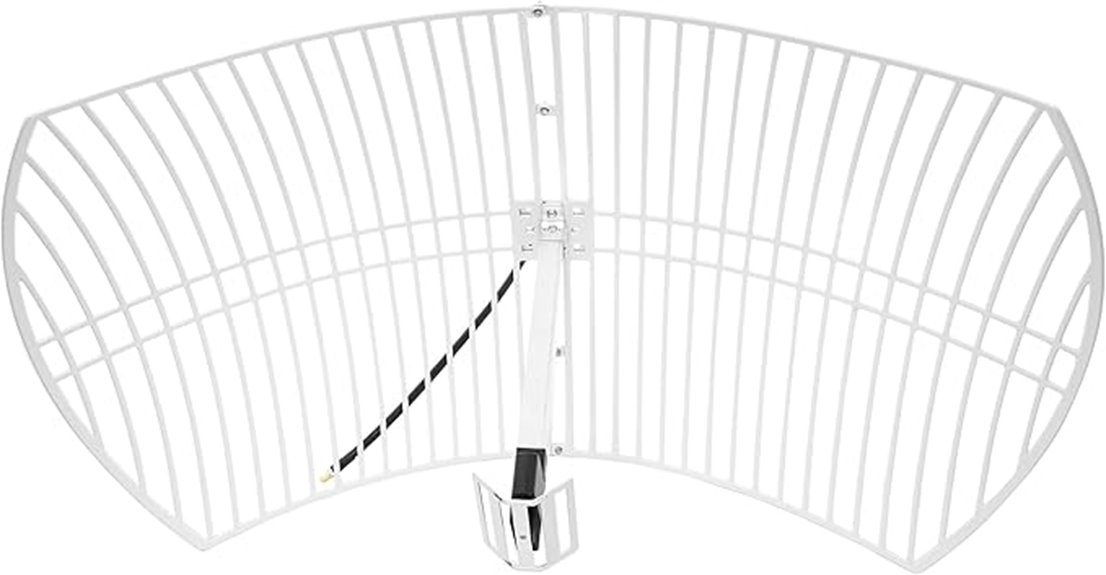
The Nooelec GOES Weather Satellite RTL-SDR Bundle stands out as an excellent choice for weather enthusiasts and professionals who want high-resolution, near real-time images from orbiting weather satellites. It includes a powerful 21dBi parabolic reflector antenna, an NESDR SMArTee XTR SDR receiver, a GOES LNA module, and all necessary cables, making setup straightforward. Once aligned, it captures clear images from satellites like GOES-16 and GOES-17, even in challenging weather. While assembly and aiming require patience, the system delivers reliable, detailed satellite data. With responsive support and a two-year warranty, this bundle offers a versatile, high-performance solution for satellite weather monitoring.
Best For: weather enthusiasts, researchers, and hobbyists seeking high-resolution, real-time satellite imagery from orbiting weather satellites.
Pros:
- Includes a high-gain 21dBi parabolic antenna and all necessary components for a complete setup
- Capable of receiving clear, detailed images from satellites like GOES-16 and GOES-17
- Responsive customer support and a 2-year warranty ensure reliable assistance and peace of mind
Cons:
- Assembly and aiming can be time-consuming and require patience, especially for fine adjustments
- Weatherproofing components, such as the SAWbird+ filter, need extra protection against water and elements
- Adjusting skew and fine-tuning the antenna may require hardware upgrades or removal of the antenna from its mount
Nooelec Lana Ultra Low-Noise Amplifier (LNA) Module for SDR
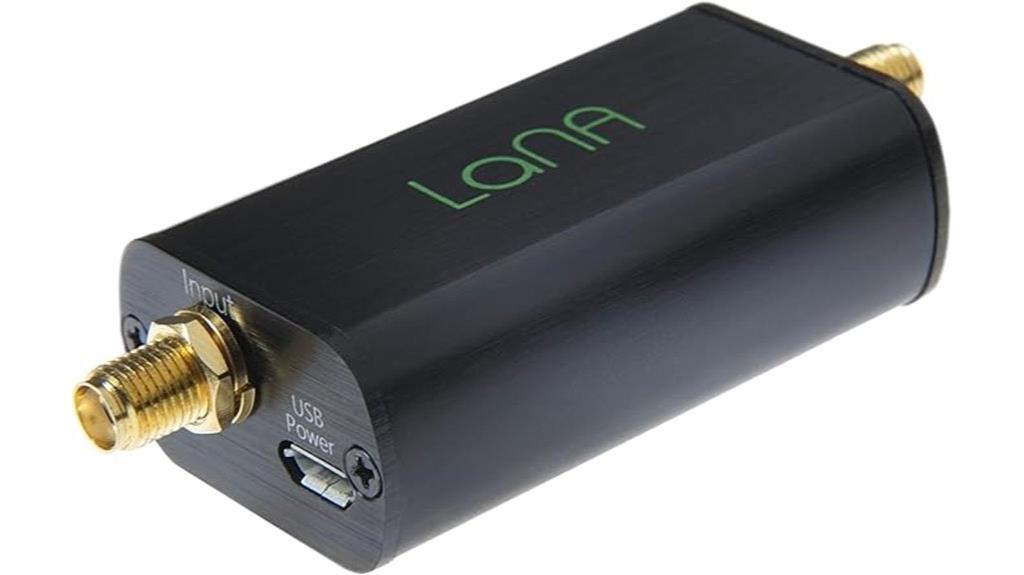
For those seeking to boost signal quality in their SDR setups, the Nooelec Lana Ultra Low-Noise Amplifier (LNA) Module stands out as an essential tool. It covers a wide frequency range from 20MHz to 4GHz, making it versatile for various radio applications. Lana provides higher gain, a lower noise figure, and better linearity than comparable modules, notably improving SNR and overall reception. Its durable aluminum enclosure ensures stability and shielding. Power options include USB, bias tee, or DC adapter, with some setups requiring a DC block to prevent interference. This LNA is compatible with RTL-SDR and other radio systems, making it a valuable upgrade for enthusiasts and professionals alike.
Best For: radio enthusiasts and professionals looking to enhance signal quality across a wide frequency range in SDR setups.
Pros:
- Ultra low-noise amplifier with high gain and improved linearity
- Wideband frequency coverage from 20MHz to 4GHz
- Durable aluminum enclosure with versatile power options including USB, bias tee, and DC adapter
Cons:
- Some setups may require a DC block to prevent interference when using external power sources
- Compatibility may vary depending on specific SDR models and configurations
- External accessories like bias tees and power adapters are necessary for optimal operation
ADS-B Antenna Set Bundle for SDRs
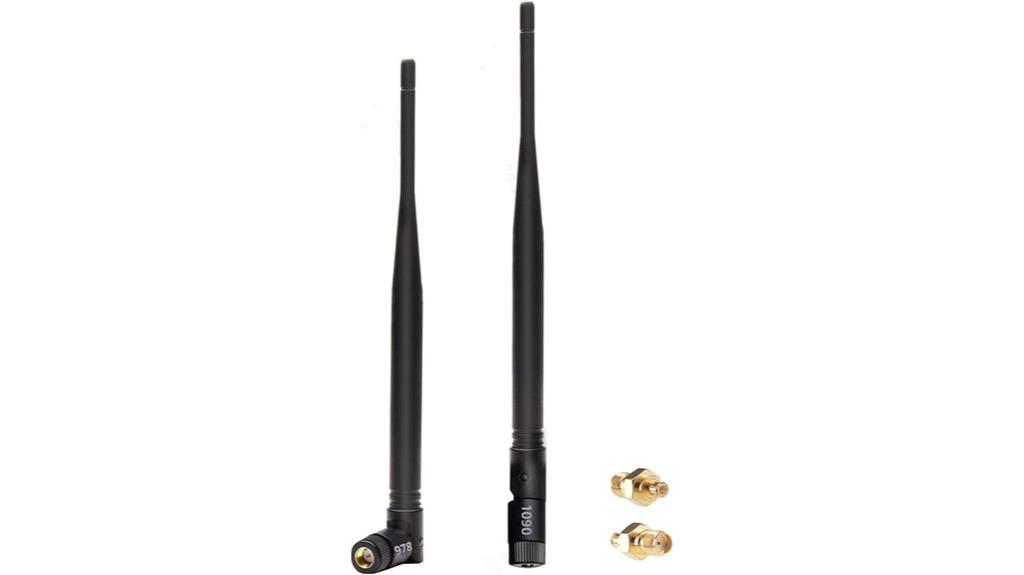
If you’re serious about capturing aircraft signals from long distances, the ADS-B Antenna Set Bundle for SDRs offers an excellent upgrade. It includes dedicated 1090MHz and 978MHz antennas with SMA connectors and MCX adaptors, optimized for aviation tracking. Each antenna has a 5dBi gain and ultra-low VSWR, ensuring strong, clear signals over extended ranges—some users report detecting aircraft over 200 miles away. The compact, lightweight design and foldable hinges make it portable and easy to mount in various environments. Praised for improved detection and ease of use, this bundle is perfect for enhancing small SDR setups and boosting aviation data feeds.
Best For: aviation enthusiasts, hobbyists, and professionals seeking to enhance ADS-B signal reception over long distances with portable, high-gain antennas.
Pros:
- High 5dBi gain and ultra-low VSWR for improved signal strength and clarity
- Compact, lightweight, and foldable design for easy portability and versatile mounting
- Compatible with all SMA and MCX-input SDRs, including bundled adapters for simple setup
Cons:
- Slightly more expensive than homemade or generic antenna options
- Requires proper mounting and outdoor setup for optimal performance
- Limited to aviation tracking signals; not suitable for other radio communications
Factors to Consider When Choosing Software‑Defined Radios (SDR)
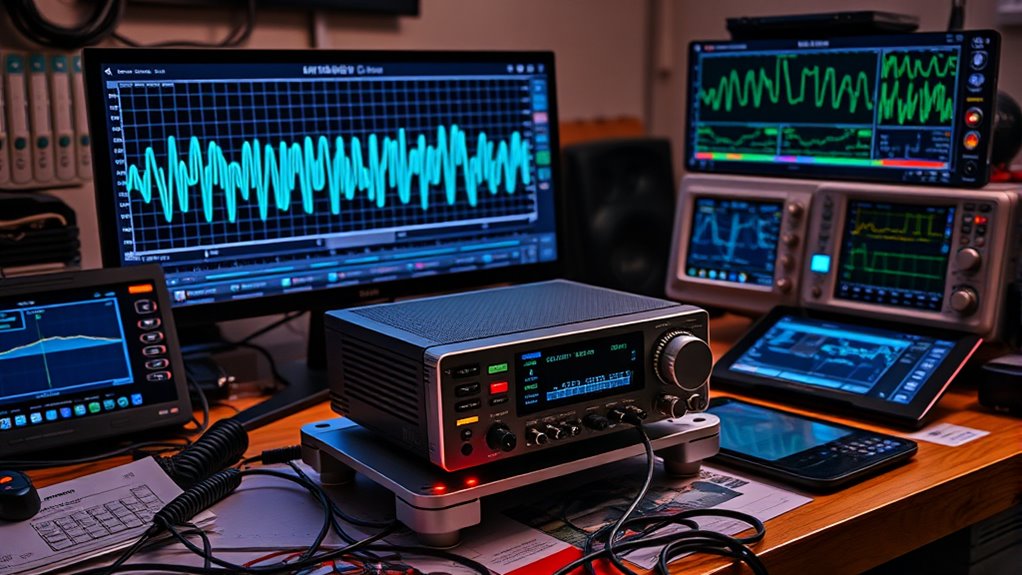
When choosing an SDR, I look at several key factors to guarantee it fits my needs. Things like frequency range, tuning bandwidth, and software compatibility are essential for peak performance. Additionally, I consider support for antennas and accessories, as well as power requirements, to make a well-informed decision.
Frequency Range Coverage
The frequency range coverage of an SDR directly impacts its ability to receive and analyze signals across different parts of the spectrum. A broad-ranging scope means I can monitor more signals, from low-frequency shortwave and amateur bands to high-frequency VHF, UHF, and even some microwave bands. Some SDRs cover as low as 100 kHz, while others reach over 1.8 GHz, influencing their suitability for specific applications. If I need to capture signals outside their native range, I can use external upconverters or upgrade components to extend their capabilities. The choice depends on my interests—whether I want extensive spectrum coverage or focus on particular bands. Clear understanding of these limits helps me pick an SDR that best fits my monitoring and analysis needs.
Tuning Bandwidth Options
Choosing the right tuning bandwidth is essential because it directly influences how effectively my SDR can process signals across different parts of the spectrum. A broader bandwidth, like 3.2 MHz, lets me monitor a wide range of frequencies simultaneously, ideal for real-time spectrum analysis. However, it can also introduce more noise and demands higher processing power. On the other hand, stable bandwidths around 2.4 MHz offer reliable performance with less digital noise, making them suitable for most general tasks. Some SDRs allow software-activatable bandwidth adjustments, giving me the flexibility to optimize performance based on the environment and hardware capabilities. Narrower bandwidths excel at capturing transient signals and detailed analysis, while wider ones support broader spectrum monitoring—it’s all about balancing detail and coverage.
Compatibility With Software
Ensuring your SDR is compatible with your preferred software is essential for a smooth setup and reliable operation. First, check that the SDR works with your operating system—Windows, macOS, Linux, Android, or Raspberry Pi—to prevent compatibility issues. Make sure it supports the software you plan to use, such as SDR#, GQRX, CubicSDR, or HDSDR, for seamless functionality. Regular driver updates from the manufacturer are crucial, as they keep your device compatible with evolving software versions. Additionally, verify that the hardware interfaces, like USB-C or SMA connectors, match your computer’s ports and antenna setup. Consulting community support and compatibility lists can also help confirm that your chosen SDR will work well with your preferred applications and decoding tools.
Antenna and Accessory Support
A good antenna setup can make or break your SDR experience, especially when working with specific frequency ranges. The effectiveness of your SDR depends heavily on choosing antennas compatible with your target signals, whether dipoles, verticals, or directional antennas. Support for accessories like preamplifiers, filters, and bias tees can markedly boost reception quality by enhancing signal strength and reducing noise. It’s essential to match the antenna connector type, such as SMA or MCX, to your SDR’s input port to ensure proper connection and peak performance. External accessories like upconverters or low-noise amplifiers can extend frequency coverage and improve sensitivity, especially in challenging environments. Additionally, mounting options like tripods or outdoor brackets help stabilize your setup for consistent, high-quality reception.
Power Supply Requirements
Power supply stability is essential for peak SDR performance, as fluctuations can cause signal dropouts or data corruption. Most SDRs rely on USB power, requiring a steady 5V supply with at least 1A of current, depending on the device. For active antennas or low-noise amplifiers, external power supplies or bias tees might be necessary to guarantee optimal operation and signal integrity. Some SDRs feature built-in bias-tee circuits that can be activated via software to power connected accessories. Using a high-quality, short, and well-shielded USB cable helps prevent power fluctuations and maintains consistent performance. Keep in mind that more advanced SDR models with higher bandwidth or multiple accessories often need dedicated power sources to deliver stable, reliable operation.
Build Quality and Durability
When selecting an SDR, I prioritize build quality because a sturdy design directly affects its longevity and performance. A well-constructed unit features a durable metal or reinforced plastic casing that shields internal components from physical damage and electromagnetic interference. High-quality connectors like SMA or MCX ensure reliable signal transmission and reduce connection issues over time. Good build quality also includes passive cooling elements, such as heat sinks or aluminum enclosures, which prevent overheating during extended use. Additionally, the use of high-grade components and motherboard-level shielding minimizes digital noise and static, providing cleaner reception. An SDR built to withstand environmental factors like humidity, temperature fluctuations, and minor impacts will last longer and maintain ideal performance, making it a smart investment for both enthusiasts and professionals.
Price and Value
Choosing the right SDR involves more than just build quality; price and value play a key role in making a smart investment. SDR prices range from under $30 for budget models like RTL-SDR dongles to over $1,000 for high-end units, affecting perceived value. For beginners and hobbyists, affordable options offer excellent performance and great value. However, investing a bit more in a model with advanced features—such as better filters or built-in upconverters—can pay off in the long run, especially for complex applications. Keep in mind, accessories like antennas, cables, and filters also impact overall value. Ultimately, consider durability, software support, and compatibility, ensuring the SDR you choose offers the best balance between cost and functionality for your specific needs.
Frequently Asked Questions
What Are the Latest Advancements in SDR Technology Expected in 2025?
In 2025, I expect SDR technology to see major advancements like higher sampling rates, improved digital signal processing, and enhanced FPGA capabilities. These innovations will boost sensitivity, bandwidth, and real-time processing. I’m excited about integrated AI features that allow smarter signal analysis and adaptive filtering. Overall, these developments will make SDRs more powerful, versatile, and user-friendly, transforming how enthusiasts and professionals approach radio communications.
How Do Software Updates Impact SDR Performance and Security?
Software updates considerably enhance SDR performance and security. They fix bugs, improve signal processing, and add new features, keeping your device current and efficient. Updates also patch vulnerabilities, protecting against cyber threats and unauthorized access. I always stay on top of updates to guarantee my SDR runs smoothly and securely. Regular updates are essential for maintaining peak performance and safeguarding sensitive data, giving me peace of mind while exploring the radio spectrum.
What Are the Best Accessories to Enhance SDR Capabilities?
The best accessories to boost my SDR capabilities include high-quality antennas, such as directional or wideband types, to improve reception. I also use low-noise amplifiers to enhance signal clarity, along with preselectors to filter out unwanted signals. A good external clock source helps with synchronization, and a robust USB interface ensures stable data transfer. These tools make my SDR experience more precise and versatile for all my projects.
How Does SDR Interoperability Improve With New Firmware Standards?
Interoperability with new firmware standards really boosts my SDR experience. It allows my radio to communicate seamlessly with different devices and protocols, making setup smoother and expanding its capabilities. I notice faster updates and better stability too. These standards create a more unified ecosystem, so I can switch between devices effortlessly, knowing they’ll work together reliably. It’s a game-changer for both my hobby and professional work.
What Emerging Applications Are Driving SDR Innovation in 2025?
Emerging applications like 5G networks, satellite communications, and IoT expansion are driving SDR innovation in 2025. I see these trends pushing developers to enhance flexibility, bandwidth, and real-time processing. These advancements enable me to explore new frequencies, improve signal clarity, and adapt quickly to changing tech landscapes. It’s exciting to witness how SDRs evolve to meet the demands of our connected world, making communication more versatile and reliable.
Conclusion
So, there you have it—your crash course in SDRs, from budget-friendly dongles to professional-grade kits. Whether you’re a curious hobbyist or a serious enthusiast, there’s an SDR out there waiting to turn your radio dreams into reality. Just remember, the only thing better than tuning into the universe’s secrets is realizing you probably spent too much on that shiny new gadget. Happy listening—and don’t forget to blame the signals, not me!
